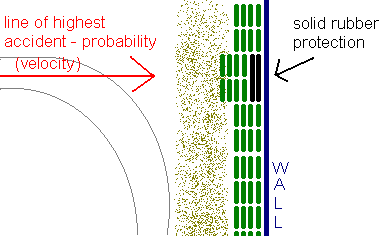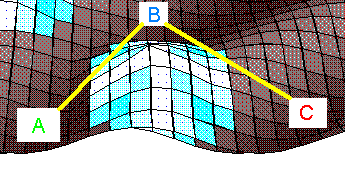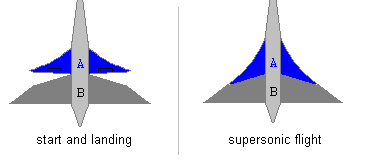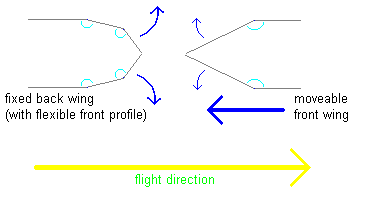
highspeed impact at Formula 1 race in Silverstone (U.K.)
possible solution:
2 stage wall impact protection (layer of wheels + solid rubber) at points
of probably high impact velocity

avalanche accidents in Austria
biggest problem for the helicopter rescue and supply teams in the past :
no sight due to snow storms and fog

possible solution for situations with acceptable wind-conditions:
GPS guided rescue operation with waypoint B above the mountains.
(at least 100 metres distance to the ground necessary to avoid provocation of an avalanche)
The lines AB and BC are interpolated due to a time scheme (Point to Point flight concept)
Psion Series 3a/3c and Excel(TM) V5.0 spreadsheet file (2 kB i.p.) for
two point (P1->P2) line interpolation (enter k=0 , k=0.1 , 0.2 , ... , 0.8 , k=0.9 for a 10 point resolution)
JFK jr.'s body buried in the sea
location : point of accident near "Martha's Vineyard"
bodies of his wife and her sister found near the wreck
(single engine PIPER "SARATOGA" plane)
U.S. coast guard dives for cockpit of plane
high impact speed of plane on the water obvious
JFK jr. did not have an instrument-flight license
golf-player Payne Stewart died in plane crash
the LearJet he owned crashed on the way from Florida (east coast) to South Dakota
the flight path was followed by six fighter aircrafts (F-16)
7 casualties (5 passengers + 2 pilots) ; everybody on board had died 4 hours before the plane crashed (low pressure -> no oxygen)
possible measurements for the future :
a) stricter oxygen mask regulations / better passenger emergency training
b) for other cases of passenger death: possibility to land the plane via
an external steering (AM/FM radio or - if available - satellite phone controlled)
the guidance by a double seated Harrier aircraft (necessary for the slow landing phase ; the second pilot operates the remote control) should be best
click here for a flight simulator that trains external landing (by now only military version available)
external link : PGA golfers association
Last commercial flight of the Concorde
landed at 16:03 GMT on October-24-2003 in London Heathrow along with 2 locally operated Concordes
flashback: Air France Concorde crash near Paris
114 casualties (109 inside plane ; 5 guests of the hotel the Concorde crashed into)
burning Rolls-Royce double-engine caused dropping of plane
Air France and British Airways cancelled all subsequent Concorde flights
British Airways has resumed flights recently
reasons for the fire :
Burning rubber/steel material (from an exploding wheel ; similiar incidents
have been reported before by British Airways) flew into the fuel-tank section
near one engine during start.
The wheel touched a metal part that had fallen off another plane on the runway.
(the runway had not been checked carefully enough after a previously executed fire-brigade exercise)

The fire was able to affect the first and second engine quickly.
note: The Boeing supersonic aircraft study operates with
4 instead of 2 separate engines (which leads to a lower risk of a 50% thrust failure due
to a fire in ONE engine)
conclusion :
If the financial situation - e.g. in cooperation with Virgin Atlantic - allows a PARTIAL redesign of the Concorde
a) the Rolls-Royce double-engines should be separated slightly :

b) at least a part of the delta-wing should be made convertible
(similiar to modern fighter aircrafts and to the convertible wing design approach that the United States once used
to create a supersonic civil aircraft of their own).
Beside other effects 2 additional flap systems at the end of these extra wings
would allow
a slower start speed (and therefor probably no more need for an after-burner),
lower fuel-consumption during start,
lower wheel temperatures/pressure,
less dangerous behaviour when particles on the runway are hit and
a later possible abort of start.
disadvantages of this concept :
a smaller number of seats in section A due to the space and weight that the
wing-conversion mechanism needs.
a greater stall-angle necessary to maintain lift-force or
substantial loss of plane's altitude during wing-conversion process.

necessary flexible profile for both partial wings :

(note: flexible wing profiles already are being tested by the aviation industry)
click here to download the corresponding animation viewer for MS-Windows(TM) 3.1x
2D/3D program (supports red-green and alternating glasses + prismatic screens) with Dynamic Data Exchange (DDE) to exchange actual
wing-angle values with other applications (e.g. drivers for electrical control-engines of demonstration models) ; Version 1.21 ; 91 kBytes .zip file.
( internal link : 'viewer' screenshot )
(this page has been updated on July-24-2006)
 MIR
MIR MIR
MIR





